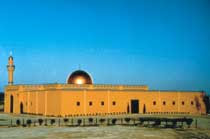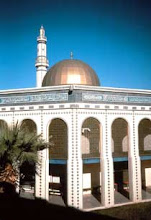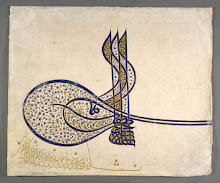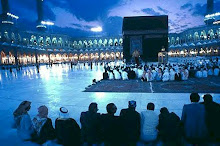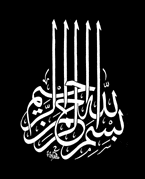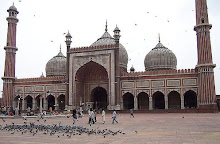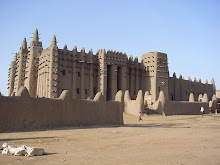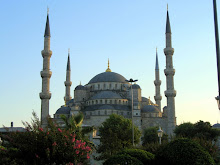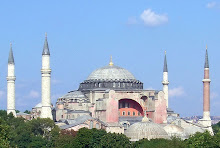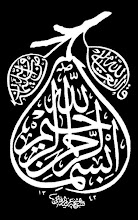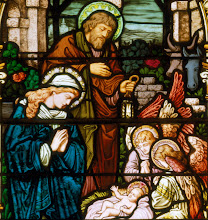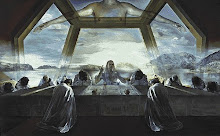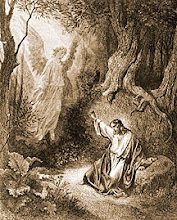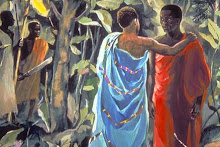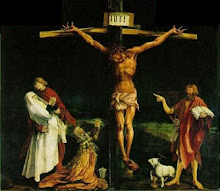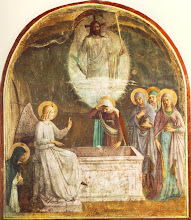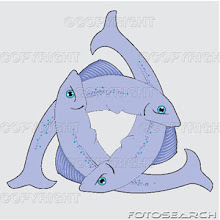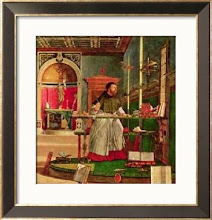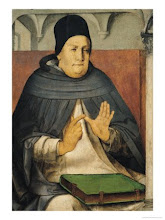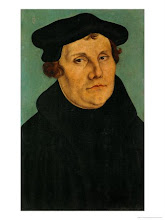The Science of Religion; The Religion of Science
Wednesday, October 24, 2007
Zoroastrianism
For 1000 years Zoroastrianism was one of the most powerful religions in the world. It was the official religion of Persia (Iran) from 600 BCE to 650 CE.
It is now one of the world's smallest religions with around a quarter of a million followers worldwide. There are 4000 Zoroastrians living in Britain.
Zoroastrians believe there is one God called Ahura Mazda (Wise Lord) and He created the world.
Zoroastrians are not fire-worshippers, as some Westerners wrongly believe. Zoroastrians believe that the elements are pure and that fire represents God's light or wisdom.
Ahura Mazda revealed the truth through the prophet, Zoroaster.
Zoroastrians traditionally pray several times a day.
Zoroastrians worship communally in a Fire Temple or Agiary.
The Zoroastrian book of Holy Scriptures is called The Avesta.
The Avesta can be roughly split into two main sections:
The Avesta is the oldest and core part of the scriptures, which contains the Gathas. The Gathas are seventeen hymns thought to be composed by Zoroaster himself.
The Younger Avesta - commentaries to the older Avestan written in later years. It also contains myths, stories and details of ritual observances.
Zoroastrians are roughly split into two groups:
The Iranians
The Parsis
Saturday, October 20, 2007
ISLAM
Muslims believe that God revealed the Qur'an to Muhammad, God's final prophet, and regard the Qur'an and the Sunnah (words and deeds of Muhammad) as the fundamental sources of Islam.[4] They do not regard Muhammad as the founder of a new religion, but as the restorer of the original monotheistic faith of Abraham, Moses, Jesus, and other prophets. Islamic tradition holds that Judaism and Christianity distorted the messages of these prophets over time either in interpretation, in text, or both.[5]
Islam includes many religious practices. Adherents are generally required to observe the Five Pillars of Islam, which are five duties that unite Muslims into a community.[6] In addition to the Five Pillars, Islamic law (sharia) has developed a tradition of rulings that touch on virtually all aspects of life and society. This tradition encompasses everything from practical matters like dietary laws and banking to warfare.[7]
Almost all Muslims belong to one of two major denominations, the Sunni and Shi'a. The schism developed in the late 7th century following disagreements over the religious and political leadership of the Muslim community. Roughly 85 percent of Muslims are Sunni and 15 percent are Shi'a. Islam is the predominant religion throughout the Middle East, as well as in parts of Africa and Asia. Large communities are also found in China, Western Europe, the Balkan Peninsula, and Russia. About 20 percent of Muslims live in Arab countries.[8]
Etymology and meaning
The word islām is derived from the Arabic verb aslama, which means to accept, surrender or submit. Thus, Islam means submission to and acceptance of God, and believers must demonstrate this by worshiping him, following his commands, and avoiding polytheism. The word is given a number of meanings in the Qur'an. In some verses (ayat), the quality of Islam as an internal conviction is stressed: "Whomsoever God desires to guide, He expands his breast to Islam."[9] Other verses connect islām and dīn (usually translated as "religion"): "Today, I have perfected your religion (dīn) for you; I have completed My blessing upon you; I have approved Islam for your religion."[10] Still others describe Islam as an action of returning to God—more than just a verbal affirmation of faith.[11]
Beliefs
According to the Qur'an all Muslims have to believe in God, his revelations, his angels, his messengers, and in the "Day of Judgment".[12] Also, there are other beliefs that differ between particular sects. The Sunni concept of predestination is called divine decree,[13] while the Shi'a version is called divine justice. Unique to the Shi'a is the doctrine of Imamah, or the political and spiritual leadership of the Imams.[14]
Muslims believe that God revealed his final message to humanity through the Islamic prophet Muhammad via the angel Gabriel. For them, Muhammad was God's final prophet and the Qur'an is the revelations he received over more than two decades.[15] In Islam, prophets are men selected by God to be his messengers. Muslims believe that prophets are human and not divine, though some are able to perform miracles to prove their claim. Islamic prophets are considered to be the closest to perfection of all humans, and are uniquely the recipients of divine revelation—either directly from God or through angels.[16] Islamic theology says that all of God's messengers since Adam preached the message of Islam—submission to the will of the one God. Islam is described in the Qur'an as "the primordial nature upon which God created mankind",[17] and the Qur'an states that the proper name Muslim was given by Abraham.[18]
As a historical phenomenon, Islam originated in Arabia in the early 7th century.[19] Islamic texts depict Judaism and Christianity as prophetic successor traditions to the teachings of Abraham. The Qur'an calls Jews and Christians "People of the Book" (ahl al-kitāb), and distinguishes them from polytheists. Muslims believe that parts of the previously revealed scriptures, the Tawrat (Torah) and the Injil (Gospels), had become distorted—either in interpretation, in text, or both.[5]
Allah
Islam's fundamental theological concept is tawhīd—the belief that there is only one God. The Arabic term for God is Allāh; most scholars believe it was derived from a contraction of the words al- (the) and ʾilāh (deity, masculine form), meaning "the God" (al-ilāh), but others trace its origin to the Aramaic Alāhā.[20] The first of the Five Pillars of Islam, tawhīd is expressed in the shahadah (testification), which declares that there is no god but God, and that Muhammad is God's messenger. In traditional Islamic theology, God is beyond all comprehension; Muslims are not expected to visualize God but to worship and adore him as a protector. Although Muslims believe that Jesus was a prophet, they reject the Christian doctrine of the Trinity, comparing it to polytheism. In Islamic theology, Jesus is just a man and not the son of God;[21] God is described in a chapter (sura) of the Qur'an as "…God, the One and Only; God, the Eternal, Absolute; He begetteth not, nor is He begotten; And there is none like unto Him."[22]
Qur'an
The first sura in a Qur'anic manuscript by Hattat Aziz EfendiMuslims consider the Qur'an to be the literal word of God; it is the central religious text of Islam.[23] Muslims believe that the verses of the Qur'an were revealed to Muhammad by God through the angel Gabriel on many occasions between the years 610 and his death on July 6, 632. The Qur'an was written down by Muhammad's companions (sahabah) while he was alive, although the prime method of transmission was orally. It was compiled in the time of Abu Bakr, the first caliph, and was standardized in the time of Uthman, the third caliph. From textual evidence, modern Western academics find that the Qur'an of today has not changed over the years.[24]
The Qur'an is divided into 114 suras, or chapters, which combined, contain 6,236 āyāt, or poetic verses. The chronologically earlier suras, revealed at Mecca, are primarily concerned with ethical and spiritual topics. The later Medinan suras mostly discuss social and moral issues relevant to the Muslim community.[25] The Qur'an is more concerned with moral guidance than legal instruction, and is considered the "sourcebook of Islamic principles and values".[26] Muslim jurists consult the hadith, or the written record of Muhammad's life, to both supplement the Qur'an and assist with its interpretation. The science of Qur'anic commentary and exegesis is known as tafsir.[27]
The word Qur'an means "recitation". When Muslims speak in the abstract about "the Qur'an", they usually mean the scripture as recited in Arabic rather than the printed work or any translation of it. To Muslims, the Qur'an is perfect only as revealed in the original Arabic; translations are necessarily deficient because of language differences, the fallibility of translators, and the impossibility of preserving the original's inspired style. Translations are therefore regarded only as commentaries on the Qur'an, or "interpretations of its meaning", not as the Qur'an itself.[28]
Angels
Belief in angels is crucial to the faith of Islam. The Arabic word for Angels (malak) means "messenger", like its counterparts in Hebrew (malakh) and Greek (angelos). According to the Qur'an, angels do not possess free will, and worship God in perfect obedience.[29] Angels' duties include communicating revelations from God, glorifying God, recording every person's actions, and taking a person's soul at the time of death. They are also thought to intercede on man's behalf. The Qur'an describes angels as "messengers with wings—two, or three, or four (pairs): He [God] adds to Creation as He pleases…"[30]
Muhammad
Muhammad (c. 570 – July 6, 632) was an Arab religious, political, and military leader who founded the religion of Islam as a historical phenomenon. Muslims view him not as the creator of a new religion, but as the restorer of the original, uncorrupted monotheistic faith of Adam, Abraham and others. In Muslim tradition, Muhammad is viewed as the last and the greatest in a series of prophets—as the man closest to perfection, the possessor of all virtues.[31] For the last 23 years of his life, beginning at age 40, Muhammad reported receiving revelations from God. The content of these revelations, known as the Qur'an, was memorized and recorded by his companions.[32]
The Masjid al-Nabawi ("Mosque of the Prophet") in Medina is the site of Muhammad's tomb.During this time, Muhammad preached to the people of Mecca, imploring them to abandon polytheism. Although some converted to Islam, Muhammad and his followers were persecuted by the leading Meccan authorities. After 13 years of preaching, Muhammad and the Muslims performed the Hijra ("emigration") to the city of Medina (formerly known as Yathrib) in 622. There, with the Medinan converts (Ansar) and the Meccan migrants (Muhajirun), Muhammad established his political and religious authority. Within years, two battles had been fought against Meccan forces: the Battle of Badr in 624, which was a Muslim victory, and the Battle of Uhud in 625, which ended inconclusively. Conflict with Medinan Jewish clans who opposed the Muslims led to their exile, enslavement or death, and the Jewish enclave of Khaybar was subdued. At the same time, Meccan trade routes were cut off as Muhammad brought surrounding desert tribes under his control.[33] By 629 Muhammad was victorious in the nearly bloodless Conquest of Mecca, and by the time of his death in 632 he ruled over the Arabian peninsula.[34]
In Islam, the "normative" example of Muhammad's life is called the Sunnah (literally "trodden path"). This example is preserved in traditions known as hadith ("reports"), which recount his words, his actions, and his personal characteristics. The classical Muslim jurist ash-Shafi'i (d. 820) established the importance of the Sunnah in Islamic law, and Muslims were encouraged to emulate Muhammad's actions in their daily lives. The Sunnah is seen as crucial to guiding interpretation of the Qur'an.[35]
Resurrection and judgment
Belief in the "Day of Resurrection", yawm al-Qiyāmah (also known as yawm ad-dīn, "Day of Judgment" and as-sā`a, "the Last Hour") is also crucial for Muslims. They believe that the time of Qiyāmah is preordained by God but unknown to man. The trials and tribulations preceding and during the Qiyāmah are described in the Qur'an and the hadith, and also in the commentaries of Islamic scholars. The Qur'an emphasizes bodily resurrection, a break from the pre-Islamic Arabian understanding of death. It states that resurrection will be followed by the gathering of mankind, culminating in their judgment by God.[36]
The Qur'an lists several sins that can condemn a person to hell, such as disbelief, usury and dishonesty. Muslims view paradise (jannah) as a place of joy and bliss, with Qur'anic references describing its features and the physical pleasures to come. There are also references to a greater joy—acceptance by God (ridwān).[37] Mystical traditions in Islam place these heavenly delights in the context of an ecstatic awareness of God.[38]
Predestination
In accordance with the Islamic belief in predestination, or divine preordainment (al-qadā wa'l-qadar), God has full knowledge and control over all that occurs. This is explained in Qur'anic verses such as "Say: 'Nothing will happen to us except what Allah has decreed for us: He is our protector'…"[39] For Muslims, everything in the world that occurs, good or evil, has been preordained and nothing can happen unless permitted by God. In Islamic theology, divine preordainment does not suggest an absence of God's indignation against evil, because any evils that do occur are thought to result in future benefits men may not be able to see. According to Muslim theologians, although events are pre-ordained, man possesses free will in that he has the faculty to choose between right and wrong, and is thus responsible for his actions. According to Islamic tradition, all that has been decreed by God is written in al-Lawh al-Mahfūz, the "Preserved Tablet".[40]
The Shi'a understanding of predestination is called "divine justice" (Adalah). This doctrine, originally developed by the Mu'tazila, stresses the importance of man's responsibility for his own actions. In contrast, the Sunni deemphasize the role of individual free will in the context of God's creation and foreknowledge of all things.[41]
Duties and practices
Five Pillars
Rituals of the Hajj (pilgrimage) include walking seven times around the Kaaba in Mecca.The Five Pillars of Islam (Arabic: : اركان الدين) are five practices essential to Sunni Islam. Shi'a Muslims subscribe to eight ritual practices which substantially overlap with the Five Pillars.[42] They are:
The shahadah, which is the basic creed or tenet of Islam: "'ašhadu 'al-lā ilāha illā-llāhu wa 'ašhadu 'anna muħammadan rasūlu-llāh", or "I testify that there is none worthy of worship except God and I testify that Muhammad is the Messenger of God." This testament is a foundation for all other beliefs and practices in Islam (although technically the Shi'a do not consider the shahadah to be a separate pillar, just a belief). Muslims must repeat the shahadah in prayer, and non-Muslims wishing to convert to Islam are required to recite the creed.[43]
Salah, or ritual prayer, which must be performed five times a day. (However, the Shi'a are permitted to run together the noon with the afternoon prayers, and the evening with the night prayers). Each salah is done facing towards the Kaaba in Mecca. Salah is intended to focus the mind on God, and is seen as a personal communication with him that expresses gratitude and worship. Salah is compulsory but flexibility in the specifics is allowed depending on circumstances. In many Muslim countries, reminders called Adhan (call to prayer) are broadcast publicly from local mosques at the appropriate times. The prayers are recited in the Arabic language, and consist of verses from the Qur'an.[44]
Zakat, or alms-giving. This is the practice of giving based on accumulated wealth, and is obligatory for all Muslims who can afford it. A fixed portion is spent to help the poor or needy, and also to assist the spread of Islam. The zakat is considered a religious obligation (as opposed to voluntary charity) that the well-off owe to the needy because their wealth is seen as a "trust from God's bounty". The Qur'an and the hadith also suggest a Muslim give even more as an act of voluntary alms-giving (sadaqah). Many Shi'ites are expected to pay an additional amount in the form of a khums tax, which they consider to be a separate ritual practice.[45]
Sawm, or fasting during the month of Ramadan. Muslims must not eat or drink (among other things) from dawn to dusk during this month, and must be mindful of other sins. The fast is to encourage a feeling of nearness to God, and during it Muslims should express their gratitude for and dependence on him, atone for their past sins, and think of the needy. Sawm is not obligatory for several groups for whom it would constitute an undue burden. For others, flexibility is allowed depending on circumstances, but missed fasts usually must be made up quickly.[46]
The Hajj, which is the pilgrimage during the Islamic month of Dhu al-Hijjah in the city of Mecca. Every able-bodied Muslim who can afford it must make the pilgrimage to Mecca at least once in his or her lifetime. When the pilgrim is about ten kilometers from Mecca, he must dress in Ihram clothing, which consists of two white seamless sheets. Rituals of the Hajj include walking seven times around the Kaaba, touching the Black Stone, running seven times between Mount Safa and Mount Marwah, and symbolically stoning the Devil in Mina. The pilgrim, or the hajji, is honored in his or her community, although Islamic teachers say that the Hajj should be an expression of devotion to God instead of a means to gain social standing.[47]
In addition to the khums tax, Shi'a Muslims consider three additional practices essential to the religion of Islam. The first is jihad, which is also important to the Sunni, but not considered a pillar. The second is Amr-Bil-Ma'rūf, the "Enjoining to Do Good", which calls for every Muslim to live a virtuous life and to encourage others to do the same. The third is Nahi-Anil-Munkar, the "Exhortation to Desist from Evil", which tells Muslims to refrain from vice and from evil actions and to also encourage others to do the same.[48]
Law
The Sharia (literally: "the path leading to the watering place") is Islamic law formed by traditional Islamic scholarship. In Islam, Sharia is the expression of the divine will, and "constitutes a system of duties that are incumbent upon a Muslim by virtue of his religious belief".[49]
Islamic law covers all aspects of life, from matters of state, like governance and foreign relations, to issues of daily living. The Qur'an defines hudud as the punishments for five specific crimes: unlawful intercourse, false accusation of unlawful intercourse, consumption of alcohol, theft, and highway robbery. The Qur'an and Sunnah also contain laws of inheritance, marriage, and restitution for injuries and murder, as well as rules for fasting, charity, and prayer. However, these prescriptions and prohibitions may be broad, so their application in practice varies. Islamic scholars (known as ulema) have elaborated systems of law on the basis of these rules and their interpretations.[50]
Fiqh, or "jurisprudence", is defined as the knowledge of the practical rules of the religion. The method Islamic jurists use to derive rulings is known as usul al-fiqh ("legal theory", or "principles of jurisprudence"). According to Islamic legal theory, law has four fundamental roots, which are given precedence in this order: the Qur'an, the Sunnah (actions and sayings of Muhammad), the consensus of the Muslim jurists (ijma), and analogical reasoning (qiyas). For early Islamic jurists, theory was less important than pragmatic application of the law. In the 9th century, the jurist ash-Shafi'i provided a theoretical basis for Islamic law by codifying the principles of jurisprudence (including the four fundamental roots) in his book ar-Risālah.[51]
Religion and state
Islamic law does not distinguish between "matters of church" and "matters of state"; the ulema function as both jurists and theologians. In practice, Islamic rulers frequently bypassed the Sharia courts with a parallel system of so-called "Grievance courts" over which they had sole control. As the Muslim world came into contact with Western secular ideals, Muslim societies responded in different ways. Turkey has been governed as a secular state ever since the reforms of Mustafa Kemal Atatürk. In contrast, the 1979 Iranian Revolution replaced a mostly secular regime with an Islamic republic led by the Ayatollah Ruholla Khomeini.[52]
Etiquette and diet
Many practices fall in the category of adab, or Islamic etiquette. This includes greeting others with "as-salamu `alaykum" ("peace be unto you"), saying bismillah ("in the name of God") before meals, and using only the right hand for eating and drinking. Islamic hygienic practices mainly fall into the category of personal cleanliness and health, such as the circumcision of male offspring. Islamic burial rituals include saying the Salat al-Janazah ("funeral prayer") over the bathed and enshrouded dead body, and burying it in a grave. Muslims, like Jews, are restricted in their diet, and prohibited foods include pig products, blood, carrion, and alcohol. All meat must come from a herbivorous animal slaughtered in the name of God by a Muslim, Jew, or Christian, with the exception of game that one has hunted or fished for oneself. Food permissible for Muslims is known as halal food.[53]
Jihad
Jihad means "to strive or struggle," especially in the idiomatic expression "striving in the way of God (al-jihad fi sabil Allah) and is considered the "sixth pillar of Islam" by a minority of Muslim authorities.[54] Jihad, in its broadest sense, is classically defined as "exerting one's utmost power, efforts, endeavors, or ability in contending with an object of disapprobation." Depending on the object being a visible enemy, the devil, and aspects of one's own self, different categories of Jihad are defined: Jihad against one's own self (self-perfection), Jihad of the tongue, Jihad of the hand, and Jihad of the sword. Jihad however when used without any qualifier is understood in its military aspect. [55][56]
Jihad is the only form of warfare permissible under Islamic law. Under most circumstances and for most Muslims, jihad is a collective duty (fard kifaya): one whose performance by some individuals exempts the others; for the rest of the populace, this happens only in the case of a general mobilization.[57] Some Muslim authorities, especially among the Shi'a and Sufis, distinguish between the "greater jihad", which pertains to spiritual self-perfection, and the "lesser jihad", defined as warfare.[58] Jihad also refers to one's striving to attain religious and moral perfection.[59]
History
Islam's historical development resulted in major political, economic, and military effects inside and outside the Islamic world. Within a century of Muhammad's first recitations of the Qur'an, an Islamic empire stretched from the Atlantic Ocean in the west to Central Asia in the east. This new polity soon broke into civil war, and successor states fought each other and outside forces. However, Islam continued to spread into regions like Africa, the Indian subcontinent, and Southeast Asia. The Islamic civilization was one of the most advanced in the world during the Middle Ages, but was surpassed by Europe with the economic and military growth of the West. During the 18th and 19th centuries, Islamic dynasties such as the Ottomans and Mughals fell under the sway of European imperial powers. In the 20th century new religious and political movements and newfound wealth in the Islamic world led to both rebirth and conflict.[60]
Rise of empire (632–750)
Further information: Succession to Muhammad, Muslim conquests, and Muslim Empire
Muhammad began preaching Islam at Mecca before migrating to Medina, from where he united the tribes of Arabia into a singular Arab Muslim religious polity. With Muhammad's death in 632, disagreement broke out over who would succeed him as leader of the Muslim community. Umar ibn al-Khattab, a prominent companion of Muhammad, nominated Abu Bakr, who was Muhammad's intimate friend and collaborator. Others added their support and Abu Bakr was made the first caliph. This choice was disputed by some of Muhammad's companions, who held that Ali ibn Abi Talib, his cousin and son-in-law, had been designated his successor. Abu Bakr's immediate task was to avenge a recent defeat by Byzantine (or Eastern Roman Empire) forces, although he first had to put down a rebellion by Arab tribes in an episode known as the Ridda wars, or "Wars of Apostasy".[61]
The territory of the Caliphate in the year 750His death in 634 resulted in the succession of Umar as the caliph, followed by Uthman ibn al-Affan and Ali ibn Abi Talib. These four are known as al-khulafā' ar-rāshidūn ("Rightly Guided Caliphs"). Under them, the territory under Muslim rule expanded deeply into Persian Empire and Byzantine territories.[62] When Umar was assassinated in 644, the election of Uthman as successor was met with increasing opposition. In 656, Uthman was also killed, and Ali assumed the position of caliph. After fighting off opposition in the first civil war (the "First Fitna"), Ali was assassinated by Kharijites in 661. Following this, Mu'awiyah, who was governor of Levant, seized power and began the Umayyad dynasty.[63]
These disputes over religious and political leadership would give rise to schism in the Muslim community. The majority accepted the legitimacy of the three rulers prior to Ali, and became known as Sunnis. A minority disagreed, and believed that Ali was the only rightful successor; they became known as the Shi'a.[64] After Mu'awiyah's death in 680, conflict over succession broke out again in a civil war known as the "Second Fitna". Afterward, the Umayyad dynasty prevailed for seventy years, and was able to conquer the Maghrib as well as the Al-Andalus (the Iberian Peninsula, former Visigothic Hispania) and the Narbonnese Gaul. While the Muslim-Arab elite engaged in conquest, some devout Muslims began to question the piety of indulgence in a worldly life, emphasizing rather poverty, humility and avoidance of sin based on renunciation of bodily desires. Devout Muslim ascetic exemplars such as Hasan al-Basri would inspire a movement that would evolve into Sufism.[65]
For the Umayyad aristocracy, Islam was viewed as a religion for Arabs only;[66] the economy of the Umayyad empire was based on the assumption that a majority of non-Muslims (Dhimmis) would pay taxes to the minority of Muslim Arabs. A non-Arab who wanted to convert to Islam was supposed to first become a client of an Arab tribe. Even after conversion, these new Muslims (mawali) did not achieve social and economic equality with the Arabs. The descendants of Muhammad's uncle Abbas ibn Abd al-Muttalib rallied discontented mawali, poor Arabs, and some Shi'a against the Umayyads and overthrew them with the help of their propagandist and general Abu Muslim, inaugurating the Abbasid dynasty in 750.[67] Under the Abbasids, Islamic civilization flourished in the "Islamic Golden Age", with its capital at the cosmopolitan city of Baghdad.[68]
Golden Age (750–1258)
Artistic depiction of the Battle of Hattin in 1187, where Jerusalem was recaptured by Saladin's Ayyubid forcesBy the late 9th century, the Abbasid caliphate began to fracture as various regions gained increasing levels of autonomy. Across North Africa, Persia, and Central Asia emirates formed as provinces broke away. The monolithic Arab empire gave way to a more religiously homogenized Muslim world where the Shia Fatimids contested even the religious authority of the caliphate. By 1055 the Seljuq Turks had eliminated the Abbasids as a military power, nevertheless they continued to respect the caliph's titular authority.[69] During this time expansion of the Muslim world continued, by both conquest and peaceful proselytism even as both Islam and Muslim trade networks were extending into sub-Saharan West Africa, Inner Asia, Volga Bulgaria and the Malay archipelago.[1]
The Golden Age saw new legal, philosophical, and religious developments. The major hadith collections were compiled and the four modern Sunni Madh'habs were established. Islamic law was advanced greatly by the efforts of the early 9th century jurist al-Shafi'i; he codified a method to establish the reliability of hadith, a topic which had been a locus of dispute among Islamic scholars.[70] Philosophers Ibn Sina (Avicenna) and Al-Farabi sought to incorporate Greek principles into Islamic theology, while others like the 11th century theologian Abu Hamid al-Ghazzali argued against them and ultimately prevailed.[71] Finally, Sufism and Shi'ism both underwent major changes in the 9th century. Sufism became a full-fledged movement that had moved towards mysticism and away from its ascetic roots, while Shi'ism split due to disagreements over the succession of Imams.[72]
Starting in the 9th century, Muslim conquests in Christian Europe began to be reversed. The Reconquista was launched against Muslim principalities in Iberia, and Muslim Italian possessions were lost to the Normans. From the 11th Century onwards a series of wars known as the Crusades brought the Muslim world into conflict with Christendom. Successful at first in their capturing of the Holy land which resulted in the establishment of the Crusader states, Crusader gains in the Holy Land were reversed by later Muslim generals such as Saladin, who recaptured Jerusalem during the Second Crusade.[73] The Mongol Empire put an end to the Abbasid dynasty at the Battle of Baghdad in 1258, which saw the Muslims overrun by the superior Mongol army. Meanwhile in Egypt, the slave-soldier Mamluks took control in an uprising in 1250.[74]
Ottomans and Islamic empires in India (1258–1918)
The Seljuk Turks fell apart rapidly in the second half of the 13th century. In the 13th and 14th centuries the Ottoman empire (named after Osman I) was established with a string of conquests that included the Balkans, parts of Greece, and western Anatolia. In 1453 under Mehmed II the Ottomans laid siege to Constantinople, the capital of Byzantium. The Byzantine fortress succumbed shortly thereafter, having been battered by superior Ottoman cannonry.[75]
Beginning in the 13th century, Sufism underwent a transformation, largely as a result of the efforts of al-Ghazzali to legitimize and reorganize the movement. He developed the model of the Sufi order—a community of spiritual teachers and students.[76] Also of importance to Sufism was the creation of the Masnavi, a collection of mystical poetry by the 13th century Persian poet Rumi. The Masnavi had a profound influence on the development of Sufi religious thought; to many Sufis it is second in importance only to the Qur'an.[77]
The Taj Mahal is a mausoleum located in Agra, India, that was built under Mughal[78]In the early 16th century, the Shi'ite Safavid dynasty assumed control in Persia and established Shi'a Islam as an official religion there, and despite periodic setbacks, the Safavids remained powerful for two centuries. Meanwhile, Mamluk Egypt fell to the Ottomans in 1517, who then launched a European campaign which reached as far as the gates of Vienna in 1529.[79] Many Islamic dynasties ruled parts of the Indian subcontinent starting from the twelfth century. The prominent ones include the Delhi Sultanate (1206–1526) and the Mughal empire (1526–1857). These empires helped in the spread of Islam in South Asia. but by the mid-18th century the British empire had ended the Mughal dynasty.[80] In the 18th century the Wahhabi movement took hold in Saudi Arabia. Founded by the preacher Ibn Abd al-Wahhab, Wahhabism is a fundamentalist ideology that condemns practices like Sufism and the veneration of saints as un-Islamic.[81]
By the 17th and 18th centuries, despite attempts at modernization, the Ottoman empire had begun to feel threatened by European economic and military advantages. In the 19th century, the rise of nationalism resulted in Greece declaring and winning independence in 1829, with several Balkan states following suit after the Ottomans suffered defeat in the Russo-Turkish War of 1877–1878. The Ottoman era came to a close at the end of World War I.[82]
Modern times (1918–present)
After World War I losses, the remnants of the empire were parceled out as European protectorates or spheres of influence. Since then most Muslim societies have become independent nations, and new issues such as oil wealth and relations with the State of Israel have assumed prominence.[83]
The 20th century saw the creation of many new Islamic "revivalist" movements. Groups such as the Muslim Brotherhood in Egypt and Jamaat-e-Islami in Pakistan advocate a totalistic and theocratic alternative to secular political ideologies. Sometimes called Islamist, they see Western cultural values as a threat, and promote Islam as a comprehensive solution to every public and private question of importance. In countries like Iran and Afghanistan (under the Taliban), revolutionary movements replaced secular regimes with Islamist states. In contrast, Liberal Islam is a movement that attempts to reconcile religious tradition with modern norms of secular governance and human rights. Its supporters say that there are multiple ways to read Islam's sacred texts, and stress the need to leave room for "independent thought on religious matters".[84]
Community
Muslim percentage of population by country
Commonly cited estimates of the Muslim population in 2007, range from 900 million to 1.3 billion. Approximately 85% are Sunni and 15% are Shi'a, with a small minority belonging to other sects. Some 30–40 countries are Muslim-majority, and Arabs account for around 20% of all Muslims worldwide. South Asia and Southeast Asia contain the most populous Muslim countries, with Indonesia, India, Pakistan, and Bangladesh having more than 100 million adherents each.[85] According to U.S. government figures, in 2006 there were 20 million Muslims in China.[86] In the Middle East, the non-Arab countries of Turkey and Iran are the largest Muslim-majority countries; in Africa, Egypt and Nigeria have the most populous Muslim communities.[85] Islam is the second largest religion after Christianity in many European countries.[87]
Mosques
Eid prayers on the holiday of Eid al-Fitr at the Badshahi Mosque, Pakistan. The days of Eid are important occasions on the Islamic calendar.A mosque is a place of worship for Muslims, who often refer to it by its Arabic name, masjid. The word mosque in English refers to all types of buildings dedicated to Islamic worship, although there is a distinction in Arabic between the smaller, privately owned mosque and the larger, "collective" mosque (masjid jāmi`). Although the primary purpose of the mosque is to serve as a place of prayer, it is also important to the Muslim community as a place to meet and study. Modern mosques have evolved greatly from the early designs of the 7th century, and contain a variety of architectural elements such as minarets.[88]
Family life
The basic unit of Islamic society is the family, and Islam defines the obligations and legal rights of family members. The father is seen as financially responsible for his family, and is obliged to cater for their well-being. The division of inheritance is specified in the Qur'an, which states that most of it is to pass to the immediate family, while a portion is set aside for the payment of debts and the making of bequests. The woman's share of inheritance is generally half of that of a man with the same rights of succession.[89] Marriage in Islam is a civil contract which consists of an offer and acceptance between two qualified parties in the presence of two witnesses. The groom is required to pay a dowry (mahr) to the bride, as stipulated in the contract.[90]
A man may marry up to four wives if he believes he can treat them equally, while a woman may marry one man only. In most Muslim countries, the process of divorce in Islam is known as talaq, which the husband initiates by pronouncing the word "divorce".[91] Scholars disagree whether Islamic holy texts justify traditional Islamic practices such as veiling and seclusion (purdah). Starting in the 20th century, Muslim social reformers argued against these restrictions and other practices such as polygamy, with varying success. At the same time, many Muslim women have attempted to reconcile tradition with modernity by combining an active life with outward modesty. Islamist groups and regimes like the Taliban mostly seek to continue traditional law as applied to women.[92]
Calendar
The formal beginning of the Muslim era was chosen to be the Hijra in 622CE, which was an important turning point in Muhammad's fortunes. The assignment of this year as the year 1 AH (Anno Hegirae) in the Islamic calendar was reportedly made by Caliph Umar. It is a lunar calendar, with nineteen ordinary years of 354 days and eleven leap years of 355 days in a thirty-year cycle. Islamic dates cannot be converted to CE/AD dates simply by adding 622 years: allowance must also be made for the fact that each Hijri century corresponds to only 97 years in the Christian calendar.[93] The year 1428AH coincides almost completely with 2007CE.
Islamic holy days fall on fixed dates of the lunar calendar, which means that they occur in different seasons in different years in the Gregorian calendar. The most important Islamic festivals are Eid al-Fitr (Arabic: عيد الفطر) on the 1st of Shawwal, marking the end of the fasting month Ramadan, and Eid al-Adha (Arabic: عيد الأضحى) on the 10th of Dhu al-Hijjah, coinciding with the pilgrimage to Mecca.[94]
Other religions
A view of the Dome of the Rock on the Temple Mount in Jerusalem, a holy site in both Islam and Judaism that has been a source of controversy
The Al-Aqsa Mosque congregation building. Muslims believe that Muhammad ascended to heaven on this site.According to Islamic doctrine, Islam was the primordial religion of mankind, professed by Adam.[95] At some point, a religious split occurred, and God began sending prophets to bring his revelations to the people.[96] In this view, Abraham, Moses, Hebrew prophets, and Jesus were all prophets of Islam, but their message and the texts of the Torah and the Gospels were corrupted by Jews and Christians. Similarly, children of non-Muslim families are born Muslims, but are converted to another faith by their parents.[97] The idea of Islamic supremacy is encapsulated in the formula "Islam is exalted and nothing is exalted above it."[98] Pursuant to this principle, Muslim women may not marry non-Muslim men, defamation of Islam is prohibited, and the testimony of a non-Muslim is inadmissible against a Muslim.[99]
Islamic law divides non-Muslims into several categories, depending on their relation with the Islamic state. Christians and Jews who live under Islamic rule are known as dhimmis. Dhimmis must pay tribute (jizya) to the Islamic state, and as such are considered "protected peoples." Historically, dhimmis enjoyed a measure of communal autonomy under their own religious leaders, but were subject to legal, social and religious restrictions as well as humiliating regulations meant to highlight the inferiority of non-Muslim subjects.[100] The status was extended to Zoroastrians and sometimes to polytheists (such as Hindus), but not to atheists or agnostics.[101] Those who live in non-Muslim lands (dar al-harb) are known as harbis, and upon entering into an alliance with the Muslim state become known as ahl al-ahd. Those who receive a guarantee of safety while residing temporarily in Muslim lands are known as ahl al-amān. Their legal position is similar to that of the dhimmi except that they are not required to pay the jizya. The people of armistice (ahl al-hudna) are those who live outside of Muslim territory and agree to refrain from attacking the Muslims.[102][103] Apostasy is prohibited, and is punishable by death.[104][105]
Denominations
Islam consists of a number of religious denominations that are essentially similar in belief but which have significant theological and legal differences. The primary division is between the Sunni and the Shi'a, with Sufism generally considered to be a mystical inflection of Islam rather than a distinct school. According to most sources, approximately 85% of the world's Muslims are Sunni and approximately 15% are Shi'a, with a small minority who are members of other Islamic sects.[106]
Sunni
Divisions of IslamSunni Muslims are the largest group in Islam. In Arabic, as-Sunnah literally means "principle" or "path". The Sunnah (the example of Muhammad's life) as recorded in the Qur'an and the hadith is the main pillar of Sunni doctrine. Sunnis believe that the first four caliphs were the rightful successors to Muhammad; since God did not specify any particular leaders to succeed him, those leaders had to be elected. Sunnis recognize four major legal traditions, or madhhabs: Hanafi, Maliki, Shafi'i and Hanbali. All four accept the validity of the others and a Muslim might choose any one that he or she finds agreeable, but other Islamic sects are believed to have departed from the majority by introducing innovations (bidah). There are also several orthodox theological or philosophical traditions within Sunnism. For example, the recent Salafi movement sees itself as restorationist and claims to derive its teachings from the original sources of Islam.[107]
Shi'a
See also: Historic background of the Sunni-Shi'a split
The Shi'a, who constitute the second-largest branch of Islam, believe in the political and religious leadership of infallible Imams from the progeny of Ali ibn Abi Talib. They believe that he, as the cousin and son-in-law of Muhammad, was his rightful successor, and they call him the first Imam (leader), rejecting the legitimacy of the previous Muslim caliphs. To them, an Imam rules by right of divine appointment and holds "absolute spiritual authority" among Muslims, having final say in matters of doctrine and revelation.[108][109] Although the Shi'a share many core practices with the Sunni, the two branches disagree over the proper importance and validity of specific collections of hadith. The Shi'a follow a legal tradition called Ja'fari jurisprudence.[110] Shi'a Islam has several branches, the largest of which is the Twelvers (iṯnāʿašariyya), while the others are the Ismaili, the Seveners, and the Zaidiyyah.[111]
Sufism
Not strictly a denomination, Sufism is a mystical-ascetic form of Islam. By focusing on the more spiritual aspects of religion, Sufis strive to obtain direct experience of God by making use of "intuitive and emotional faculties" that one must be trained to use.[112] Sufism and Islamic law are usually considered to be complementary, although Sufism has been criticized by some Muslims for being an unjustified religious innovation. Most Sufi orders, or tariqas, can be classified as either Sunni or Shi'a.[113]
Others
The Kharijites are a sect that dates back to the early days of Islam. The only surviving branch of the Kharijites is Ibadism. Unlike most Kharijite groups, Ibadism does not regard sinful Muslims as unbelievers. The Imamate is an important topic in Ibadi legal literature, which stipulates that the leader should be chosen solely on the basis of his knowledge and piety, and is to be deposed if he acts unjustly. Most Ibadi Muslims live in Oman.[114]
The Yazidi, Druze, Ahmadiyya, Bábí, Bahá'í, Berghouata and Ha-Mim religions either emerged out of Islam or came to share certain beliefs with Islam. Sikhism, founded by Guru Nanak in late fifteenth century Punjab, incorporates aspects of both Islam and Hinduism.[115]
Wednesday, October 10, 2007
Flying Spaghetti Monster
"The Church of the Flying Spaghetti Monster, while having existed in secrecy for hundreds of years, only recently came into the mainstream when this letter was published in May 2005.
With millions, if not thousands, of devout worshippers, the Church of the FSM is widely considered a legitimate religion, even by its opponents - mostly fundamentalist Christians, who have accepted that our God has larger balls than theirs.
Some claim that the church is purely a thought experiment, satire, illustrating that Intelligent Design is not science, but rather a pseudoscience manufactured by Christians to push Creationism into public schools. These people are mistaken. The Church of FSM is real, totally legit, and backed by hard science. Anything that comes across as humor or satire is purely coincidental.
You can contact me at bobby.henderson@gmail.com"
Friday, September 21, 2007
Christianity Fact Sheet
Christianity is a monotheistic religion centered on the life and teachings of Jesus of Nazareth as depicted in the New Testament. Most Christians believe Jesus to be the Son of God and the Messiah prophesied in the Old Testament, and they see the New Testament as the record of the Gospel that was revealed by Jesus. With one estimate implying 2.1 billion adherents, or approximately 33% of the world's population in 2007, Christianity is the world's largest religion. It is the predominant religion in Europe, the Americas, Southern Africa, the Philippines and Oceania. It is also growing rapidly in Asia, particularly in China and South Korea, Africa and Middle East.
Christianity began as an offshoot of Judaism, and includes the Hebrew Bible (known to Christians as the Old Testament) as well as the New Testament as its canonized scriptures. Like Judaism and Islam, Christianity is classified as an Abrahamic religion.
Beliefs
Although Christianity has always had a significant diversity of belief on bordering issues, most Christians share a common set of doctrines that they hold as essential to their faith, which include:
Jesus The ChristAs indicated by the name "Christianity", the focus of a Christian's life is a firm belief in Jesus as the Son of God and the Messiah or Christ. The title "Messiah" comes from the Hebrew word (māšiáħ) meaning anointed one. The Greek translation (Christos) is the source of the English word Christ.
Christians believe that, as the Messiah, Jesus was anointed as ruler and savior of humanity, and hold that Jesus' coming was the fulfilment of messianic prophecies of the Old Testament. The Christian concept of the Messiah differs significantly from the contemporary Jewish concept. The core Christian belief is that, through the death and resurrection of Jesus, sinful humans can be reconciled to God and thereby are offered salvation and the promise of eternal life.
While there have been theological disputes over the nature of Jesus, Christians generally believe that Jesus is God incarnate and "true God and true man" (or both fully divine and fully human). Jesus, having become fully human in all respects, suffered the pains and temptations of a mortal man, yet he did not sin. As fully God, he defeated death and rose to life again. According to the Bible, "God raised him from the dead", he ascended to heaven, to the "right hand of God",and he will return again to fulfil the rest of Messianic prophecy such as the Resurrection of the dead, the Last Judgment and establishment of the physical Kingdom of God.
According to the Gospels, Jesus was conceived by the Holy Spirit and born from the Virgin Mary. Little of Jesus' childhood is recorded there in comparison to his adulthood, especially the week before his death. The Biblical accounts of Jesus' ministry include: his baptism, miracles, preaching, teaching, and deeds.
Christians consider the resurrection of Jesus to be the cornerstone of their faith and the most important event in human history.
According to the Gospels, Jesus and his followers went to Jerusalem the week of the Passover where they were eagerly greeted by a crowd. In Jerusalem, Jesus drove money changers from the Temple, and predicted its destruction- heightening conflict with the Jewish authorities who were plotting his death.
After sharing his last meal with his disciples, Jesus went to pray in the Garden of Gethsemane where he was betrayed by his disciple Judas Iscariot and arrested by the temple guard on orders from the Sanhedrin and the high priest Caiaphas. Jesus was convicted by the Sanhedrin of blasphemy and transferred to the Roman governor Pilate, who was forced, by the close to rioting crowds, to have crucified for "inciting rebellion". Jesus died by late afternoon and was entombed.
Christians believe that God raised Jesus from the dead on the third day, that Jesus appeared to his apostles and other disciples, commissioned his disciples to "make disciples of all nations, baptizing them in the name of the Father and of the Son (Jesus) and of the Holy Spirit." and then ascended to heaven. Christians also believe that God the Father sent the Holy Spirit (or Paraclete) to the disciples. Many modern writers such as members of the Jesus Seminar and other Biblical scholars such as Michael Ramsey (a former Archbishop of Canterbury) have argued that the historical Jesus never claimed to be divine. John Hick observes that it is generally agreed among scholars today that Jesus did not claim to be God. Many also reject the historicity of the empty tomb (and thus a bodily resurrection) and many other events narrated in the gospels. They assert that Gospel accounts describing these things are probably literary fabrications. However, many other scholars and historians have maintained that the Gospel accounts of Jesus are, in fact, historically reliable. For example, the late scholar Sir Frederic Kenyon, referring to the New Testament canon, asserted that:
"The interval then between the dates of the original composition and the earliest extant evidence becomes so small as to be in fact negligible, and the last foundation for any doubt that the Sciptures have come down to us substantially as they were written has now been removed. Both the authenticity and the general integrity of the books of the New Testament may be regarded as finally established."
The purpose of Jesus' death and resurrection is described in various doctrines of atonement. Some see Jesus as a Sacrifice (substitutionary atonement) made to take away the sin of the world in a manner similar to Old Testament sacrifices. Others see Jesus' dying and suffering on the cross as a sign and demonstration from God the Father that His Son was willing to endure the shame and suffering of the cross because of his agape (parental, self-sacrificing) love for humanity. In other Scriptures which record Jesus' death and resurrection, The Gospel According to St. John compares the crucifixion of Jesus to the lifting up of the Nehushtan (brass serpent) saying that "Just as Moses lifted up the snake in the desert, so the Son of Man must be lifted up, that everyone who believes in him may have eternal life. For God so loved the world that he gave his one and only Son, that whoever believes in him shall not perish but have eternal life."
Salvation
Christians believe salvation is a gift by means of the unmerited grace of God, a gift from a loving heavenly Father who sent His only begotten Son Jesus to be their savior. Christians believe that, through faith in Jesus, one can be saved from sin and eternal death. The crucifixion of Jesus is explained as an atoning sacrifice, which, in the words of the Gospel of John, "takes away the sins of the world". One's reception of salvation is related to justification.
The operation and effects of grace are understood differently by different traditions. Catholicism and Eastern Orthodoxy teach the necessity of the free will to cooperate with grace. Reformed theology places distinctive emphasis on grace by teaching that mankind is completely incapable of self-redemption, but the grace of God overcomes even the unwilling heart
The Trinity
Most Christians believe that God is spirit , an uncreated, omnipotent, and eternal being, the creator and sustainer of all things, who works the redemption of the world through his Son, Jesus Christ.
Against this background, belief in the divinity of Christ and the Holy Spirit is expressed as the doctrine of the Holy Trinity, which describes the single Divine substance existing as three distinct and inseparable persons: the Father, the Son (Jesus Christ the eternal Word), and the Holy Spirit. According to this doctrine, God is not divided in the sense that each person has a third of the whole; rather, each person is considered to be fully God. The distinction lies in their relations, the Father being unbegotten, the Son begotten of the Father, and the Holy Spirit proceeding."Begotten", in these formulae, refers to the idea that Jesus was uncreated and "eternally begotten" of the Father.
Christians of Reformed theology also conceive salvation to be one work of the triune God in which "the three divine persons act together as one, and manifest their own proper characteristics" with the agency of the Holy Spirit as an essential element."
Trinitarian Christians trace the orthodox formula of the Trinity — The Father, and of the Son, and of the Holy Ghost — back to the resurrected Jesus himself who spoke these words, and which words were subsequently recorded in Matthew 28:16-20, and are commonly referred to as the Great Commission.
Most Christians believe the Holy Spirit inspired all Scripture, and that His active participation in a believer's life (even to the extent of "indwelling" within the believer), joining the believer's free actions with His own, is essential to living a Spirit-filled Christian life.In Catholic, Orthodox, and some Anglican theology, this indwelling is received through the sacrament called Confirmation or, in the East, Chrismation. Most Protestant traditions teach that the gift of the Holy Spirit is symbolized by baptism; however some (Baptists and comparable groups) do not attribute any sacramental significance to baptism, but believe that the indwelling of the Holy Spirit occurs at the moment of salvation. Pentecostal and Charismatic Protestants believe the baptism with the Holy Spirit is a distinct experience, separate from other experiences such as conversion or water baptism, and many Pentecostals believe it will always—or at least usually—be evident through glossolalia (speaking in tongues).
Non-Trinitarians
In antiquity, and again following the Reformation, several sects advocated views contrary to the Trinity. These views were rejected by many bishops such as Irenaeus and subsequently by the Ecumenical Councils. During the Reformation (though most Catholics, Orthodox, and Protestants accepted the value of many of the Councils) some groups rejected these councils as spiritually tainted. Clemens Ziegler, Casper Schwenckfeld, and Melchior Hoffman, advanced the view that Christ was only divine and not human. Michael Servetus denied the divinity of Christ, as did others who were tried at Augsburg in 1527.
Modalists, such as Oneness Pentecostals, regard God as a single person, with the Father, Son, and Holy Spirit considered modes or roles by which the unipersonal God expresses himself.
Latter-day Saints (commonly called Mormons) accept the divinity of the Father, Son, and Holy Spirit, but deny that they are the same being. Rather, they believe them to be separate beings united perfectly in will and purpose.They believe that the Father, like the Son, has a glorified physical body.
Present day groups who do not consider Jesus to be God include: Unitarians, descendants of Reformation era Socinians, Christadelphians,and Jehovah's Witnesses.
Muslims believe that the Christian doctrine of the Trinity is incompatible with monotheism, and they reject the Christian teaching that Jesus is the Son of God, though they affirm the virgin birth and view him as a prophet preceding Muhammad.The Qur'an also uses the title "Messiah", though with a different meaning.Muslims also dispute the historical occurrence of the crucifixion of Jesus (believing that while a crucifixion occurred, it was not of Jesus).
Christianity regards the Holy Bible, a collection of canonical books in two parts (the Old Testament and the New Testament) as authoritative: written by human authors under the inspiration of the Holy Spirit, and therefore the inerrant Word of God. Protestants believe that the Holy Scriptures contain all revealed truth necessary for salvation.
The Old Testament contains the entire Jewish Tanakh, though in the Christian canon, the books are ordered differently, and some books of the Tanakh are divided into several books by the Christian canon. While these books are part of the Christian canon, scholars of Judaism generally teach that Christians misinterpret passages from the Old Testament, or Tanakh. The Catholic and Orthodox canons include the Hebrew Jewish canon and other books which Catholics call Deuterocanonical, while Protestants consider them Apocrypha.
The first four books of the New Testament are the Gospels (Matthew, Mark, Luke and John), which recount the life and teachings of Jesus. The first three are often called synoptic because of the amount of material they share. The remainder of the New Testament consists of:
a sequel to Luke's Gospel which describes the very early history of the Church (the Acts of the Apostles), a collection of letters from early Christian leaders to congregations or individuals, (the Pauline and General epistles), and the apocalyptic Book of Revelation.
Campaigning to be a restoration of the Christian church, denominations of the Latter Day Saint movement (commonly called Mormons) are distinct from other forms of Christianity in that they consider the Book of Mormon holy scripture and comparable to the Bible. The Church of Jesus Christ of Latter-day Saints also considers the Doctrine and Covenants and the Pearl of Great Price scriptural. These four books are collectively called the Standard Works of the church, in addition to the Bible.
Interpretation
Though Christians largely agree on the content of the Bible, there is significant divergence in its interpretation, or exegesis. In antiquity, two schools of exegesis developed in Alexandria and Antioch. Alexandrine interpretation, exemplified by Origen, tended to read Scripture allegorically, while Antiochene interpretation adhered to the literal sense, holding that other meanings (called theoria) could only be accepted if based on the literal meaning.
Catholic theology distinguishes two senses of scripture: the literal and the spiritual, the latter being subdivided into the allegorical, moral, and anagogical senses. The literal sense is "the meaning conveyed by the words of Scripture and discovered by exegesis, following the rules of sound interpretation." The allegorical sense includes typology, for example the parting of the Red Sea is seen as a "type" of or sign of baptism; the moral sense contains ethical teaching; the anagogical sense includes eschatology and applies to eternity and the consummation of the world. Catholic theology also adds other rules of interpretation which include:
the injunction that all other senses of sacred scripture are based on the literal,
that the historicity of the Gospels must be absolutely and constantly held,
that scripture must be read within the "living Tradition of the whole Church",and that
"the task of interpretation has been entrusted to the bishops in communion with the successor of Peter, the Bishop of Rome."
Many Protestants stress the literal sense or historical-grammatical method, even to the extent of rejecting other senses altogether. Other Protestant interpreters make use of typology. Protestants characteristically believe that ordinary believers may reach an adequate understanding of Scripture because Scripture itself is clear (or "perspicuous"), because of the help of the Holy Spirit, or both. Martin Luther believed that without God's help Scripture would be "enveloped in darkness", He advocated "one definite and simple understanding of Scripture."And John Calvin wrote, "all who refuse not to follow the Holy Spirit as their guide, find in the Scripture a clear light." The Second Helvetic Confession said, "we hold that interpretation of the Scripture to be orthodox and genuine which is gleaned from the Scriptures themselves (from the nature of the language in which they were written, likewise according to the circumstances in which they were set down, and expounded in the light of like and unlike passages and of many and clearer passages)." The writings of the Church Fathers, and decisions of Ecumenical Councils, though "not despise[d]", were not authoritative and could be rejected.
Creeds
Creeds, or concise doctrinal statements, began as baptismal formulas and were later expanded during the Christological controversies of the fourth and fifth centuries. The earliest creeds still in common use are the Apostles' Creed and Paul's creed of 1 Cor 15:1-9.
The Nicene Creed, largely a response to Arianism, was formulated at the Councils of Nicaea and Constantinople in 325 and 381 respectively, and ratified as the universal creed of Christendom by the Council of Ephesus in 431.
The Chalcedonian Creed, developed at the Council of Chalcedon in 451,(though not accepted by the Oriental Orthodox Churches) taught Christ "to be acknowledged in two natures, inconfusedly, unchangeably, indivisibly, inseparably": one divine and one human, that both natures are perfect but are nevertheless perfectly united into one person.
The Athanasian Creed (English translations), received in the western Church as having the same status as the Nicene and Chalcedonian, says: "We worship one God in Trinity, and Trinity in Unity; neither confounding the Persons not dividing the Substance."
Most Protestants accept the Creeds. Some Protestant traditions believe Trinitarian doctrine without making use of the Creeds themselves,while other Protestants, like the Restoration Movement, oppose the use of creeds.
Afterlife and Eschaton
Most Christians believe that upon bodily death the soul experiences the particular judgment and is either rewarded with eternal heaven or condemned to an eternal hell. The elect are called "saints" (Latin sanctus: "holy") and the process of being made holy is called sanctification. In Catholicism, those who die in a state of grace but with either unforgiven venial sins or incomplete penance, undergo purification in purgatory to achieve the holiness necessary for entrance into heaven.
At the last coming of Christ, the eschaton or end of time, all who have died will be resurrected bodily from the dead for the Last Judgement, whereupon Jesus will fully establish the Kingdom of God in fulfillment of scriptural prophecies.
Some groups do not distinguish a particular judgment from the general judgment at the end of time, teaching instead that souls remain in stasis until this time (see Soul sleep). These groups, and others that do not believe in the intercession of saints, generally do not employ the word "saint" to describe those in heaven. Universalists hold that eventually all will experience salvation, thereby rejecting the concept of an eternal hell for those who are not saved.
Worship and practices
Christian life
Christians believe that Jesus is the mediator of the New Covenant. His famous Sermon on the Mount is considered by many Christian scholars to be the antitype of the proclamation of the Old Covenant by Moses from Mount Sinai.
Christians believe that all people should strive to follow Christ "put ye on the Lord Jesus Christ" in their everyday actions. For many, this includes obedience to the Ten Commandments. Jesus taught that the greatest commandments were to "love the Lord your God with all your heart, soul, mind, and strength", and to "love your neighbor as yourself." This love includes such injunctions as "feed the hungry" and "shelter the homeless", and applies to friend and enemy alike. The relationship between charity and religious practice is sometimes taken for granted today as Martin Goodman has observed: "charity in the Jewish and Christian sense was unknown to the pagan world." Other Christian practices include acts of piety such as prayer and Bible reading. Christianity teaches that one can overcome sin only through divine grace: moral and spiritual progress can occur only with God's help through the gift of the Holy Spirit dwelling within the believer. It also teaches that, by believing in Christ, and sharing in Christ's life, death, and resurrection, God's children become dead to sin and are resurrected to a new life with Him.
Christian Love (Agape)
In addition, most Christians believe that the holy scriptures teach them to live their Christian lives within the boundaries of love, for, as it is written, “Master, which is the great commandment in the law? Jesus said unto him, Thou shalt love the Lord thy God with all thy heart, and with all thy soul, and with all thy mind. This is the first and great commandment. And the second is like unto it, Thou shalt love thy neighbour as thyself. On these two commandments hang all the law and the prophets.”
'Άgapē' (IPA: [ɑˈgɑ.pε] or IPA: [ˈɑgɑˌpε]) (Gk. άγάπη [aˈɣa.pi]), is one of several Greek words translated into English as love, generally, but not always, because 'agapē' also means: "from 25; love, i.e. affection or benevolence; spec. (plur.) a love-feast: - (feast of) charity ([-ably]), dear, love.
Saint Paul, writing (as most Christians believe) by inspiration of God, used the word 'agapē' in as follows: 'agapē' suffereth long, and is kind; 'agapē' envieth not; 'agapē' vaunteth not itself, is not puffed up, Doth not behave itself unseemly, seeketh not her own, is not easily provoked, thinketh no evil; Rejoiceth not in iniquity, but rejoiceth in the truth; Beareth all things, believeth all things, hopeth all things, endureth all things.'Άgapē' never faileth.
Agapē' has been used in different ways by a variety of contemporary and ancient sources, including Biblical authors. Many have supposed that 'agapē' represents divine, unconditional, self-sacrificing, active, volitional, and thoughtful love. Greek philosophers at the time of Plato and other ancient authors, used 'agapē' to denote love of a spouse or family, or affection for a particular activity, in contrast to philia — an affection that could denote either brotherhood or generally non-sexual affection, and eros, an affection of a sexual nature, usually between man and woman. The word agape is rarely used in ancient manuscripts, but was used by the early Christians to refer to the self-sacrificing love of God for humanity, which they were committed to reciprocating and practicing toward God and among one another. Άgapē has been expounded upon by many Christian writers in a specifically Christian context. Thomas Jay Oord has defined agape as "an intentional response to promote well-being when responding to that which has generated ill-being." Άgapē received a broader usage under later Christian writers as the word that specifically denoted "Christian" love or "charity"or even God himself [Theos ein agape, "... for God is Love.". Various senses of agapē are used throughout the New Testament, some expanding the meanings used in ancient texts, and rendered as: brotherly love, love of one's spouse or children, and the love of God for all people.
Christian writers have generally described 'agapē', as used by Jesus, as a form of love which is both unconditional and voluntary; that is, it is non-discriminating, has no pre-conditions, and is something that one decides to do. Tertullian, in his 2nd century defense of Christians remarks how Christian love attracted pagan notice: "What marks us in the eyes of our enemies is our loving kindness. 'Only look' they say, 'look how they love one another'".
Liturgical worship
Justin Martyr described second century Christian liturgy in his First Apology (c. 150) to
Emperor Antoninus Pius, and his description remains relevant to the basic structure of Christian liturgical worship:
The Holy Bible, Crucifix, and Rosary
"And on the day called Sunday, all who live in cities or in the country gather together to one place, and the memoirs of the apostles or the writings of the prophets are read, as long as time permits; then, when the reader has ceased, the president verbally instructs, and exhorts to the imitation of these good things. Then we all rise together and pray, and, as we before said, when our prayer is ended, bread and wine and water are brought, and the president in like manner offers prayers and thanksgivings, according to his ability, and the people assent, saying Amen; and there is a distribution to each, and a participation of that over which thanks have been given, and to those who are absent a portion is sent by the deacons. And they who are well to do, and willing, give what each thinks fit; and what is collected is deposited with the president, who succours the orphans and widows and those who, through sickness or any other cause, are in want, and those who are in bonds and the strangers sojourning among us, and in a word takes care of all who are in need."
Thus, as Justin described, Christians assemble for communal worship on Sunday, the day of the resurrection, though other liturgical practices often occur outside this setting. Scripture readings are drawn from the Old and New Testaments, but especially the Gospels. Often these are arranged on an annual cycle, using a book called a lectionary. Instruction is given based on these readings, called a sermon, or homily. There are a variety of congregational prayers, including thanksgiving, confession, and intercession, which occur throughout the service and take a variety of forms including recited, responsive, silent, or sung. The Lord's Prayer, or Our Father, is regularly prayed. The Eucharist (also called Holy Communion, or the Lord's Supper) consists of a ritual meal of consecrated bread and wine, discussed in detail below. Lastly, a collection occurs in which the congregation donates money for the support of the Church and for charitable work.
Some groups depart from this traditional liturgical structure. A division is often made between "High" church services, characterized by greater solemnity and ritual, and "Low" services, but even within these two categories there is great diversity in forms of worship. Seventh-day Adventists meet on Saturday (the original Sabbath), while others do not meet on a weekly basis. Charismatic or Pentecostal congregations may spontaneously feel led by the Holy Spirit to action rather than follow a formal order of service, including spontaneous prayer. Quakers sit quietly until moved by the Holy Spirit to speak. Some Evangelical services resemble concerts with rock and pop music, dancing, and use of multimedia. For groups which do not recognize a priesthood distinct from ordinary believers the services are generally lead by a minister, preacher, or pastor. Still others may lack any formal leaders, either in principle or by local necessity. Some churches use only a cappella music, either on principle (e.g. many Churches of Christ object to the use of instruments in worship) or by tradition (as in Orthodoxy).Worship can be varied for special events like baptisms or weddings in the service or significant feast days. In the early church Christians and those yet to complete initiation would separate for the Eucharistic part of the worship. In many churches today, adults and children will separate for all or some of the service to receive age-appropriate teaching. Such children's worship is often called Sunday school or Sabbath school (Sunday schools are sometimes held before rather than during services).
Sacraments
The Eucharist
A sacrament is a Christian rite that is an outward sign of an inward grace, instituted by Christ to sanctify humanity. Catholic, Orthodox, and some Anglican Christians describe worship in terms of seven sacraments: Baptism, Confirmation or Chrismation, Eucharist (communion), Penance (reconciliation), Anointing of the Sick (last rites), Holy Orders (ordination), and Matrimony. Many Protestant groups, following Martin Luther, recognize the sacramental nature of baptism and Eucharist, but not usually the other five in the same way, while other Protestant groups reject sacramental theology. Latter-day saint worship emphasizes the symbolic role of rites, calling some ordinances. Though not sacraments, Pentecostal, Charismatic, and Holiness Churches emphasize "gifts of the Spirit" such as spiritual healing, prophecy, exorcism, glossolalia (speaking in tongues), and laying on of hands where God's grace is mysteriously manifest.
The Eucharist (also called Holy Communion, or the Lord's Supper) is the part of liturgical worship that consists of a consecrated meal, usually bread and wine. Justin Martyr described the Eucharist as follows:
"And this food is called among us Eukaristia [the Eucharist], of which no one is allowed to partake but the man who believes that the things which we teach are true, and who has been washed with the washing that is for the remission of sins, and unto regeneration, and who is so living as Christ has enjoined. For not as common bread and common drink do we receive these; but in like manner as Jesus Christ our Saviour, having been made flesh by the Word of God, had both flesh and blood for our salvation, so likewise have we been taught that the food which is blessed by the prayer of His word, and from which our blood and flesh by transmutation are nourished, is the flesh and blood of that Jesus who was made flesh."
Orthodox, Roman Catholics, Lutherans, and many Anglicans believe that the bread and wine become the body and blood of Christ (the doctrine of the Real Presence). Most other Protestants, especially Reformed, believe the bread and wine merely represent the body and blood of Christ. These Protestants may celebrate it less frequently, while in the Roman Catholic Church the Eucharist is celebrated daily (but not on Good Friday and Holy Saturday). Catholic and Orthodox view communion as indicating those who are already united in the church, restricting participation to their members not in a state of mortal sin. In some Protestant churches participation is by prior arrangement with a church leader. Other churches view communion as a means to unity, rather than an end, and invite all Christians or even anyone to participate.
Liturgical calendar
In the New Testament Paul of Tarsus organised his missionary travels around the celebration of Pentecost. (Acts 20.16 and 1 Corinthians 16.8) This practice draws from Jewish tradition, with such feasts as the Feast of Tabernacles, the Passover, and the Jubilee. Today Catholics, Eastern Christians, and traditional Protestant communities frame worship around a liturgical calendar. This includes holy days, such as solemnities which commemorate an event in the life of Jesus or the saints, periods of fasting such as Lent, and other pious events such as memoria or lesser festivals commemorating saints. Christian groups that do not follow a liturgical tradition often retain certain celebrations, such as Christmas, Easter and Pentecost. A few churches make no use of a liturgical calendar.
Symbols
An early circular ichthys symbol, created by combining the Greek letters ΙΧΘΥΣ into a wheel. Ephesus, Asia Minor.
Today the best-known Christian symbol is the cross, which refers to the method of Jesus' execution.Several varieties exist, with some denominations tending to favor distinctive styles: Catholics the crucifix, Orthodox the crux orthodoxa, and Protestants an unadorned cross.
An earlier Christian symbol was the 'ichthys' fish (Greek Alpha - α) symbol and anagram. Other text based symbols are Greek abbreviations for Jesus Christ, originally with superlineation, to include IHC and ICXC and chi-rho (the first two letters of the word Christ in Greek). In the Greek alphabet, the Chi-Rho appears like an X (Chi - χ) with a large P (Rho - ρ) overlaid and above it. It is said Constantine saw this symbol prior to converting to Christianity (see History and origins section below). The variation IHS of the nomina sacra is latinized Greek representing the first three letters of the Latin name, Iesus. Another ancient symbol is an anchor, which denotes faith and can incorporate a cross within its design.
History and origins
The history of Christianity is the history of the Christian religion and Church, from Jesus and his Twelve Apostles to contemporary times.
In the mid-first century, Christianity spread beyond its Jewish origins under the leadership of the Apostles, especially Peter and Paul. Some scholars even consider Paul to be the founding figure of Christianity, pointing to the extent of his writings and the scope of his missionary work. Within a generation an episcopal hierarchy can be seen, and this would form the structure of the Church. In 301 Christianity became a state-religion in Armenia being the first country to accept Christianity. Christianity spread east to Asia and throughout the Roman Empire, despite persecution by the Roman Emperors until its legalization by Emperor Constantine in 313. During his reign, questions of orthodoxy lead to the convocation of the first Ecumenical Council, that of Nicaea.
Some writers consider Paul to be the founding figure of Christianity as opposed to Jesus, pointing to the extent of his writings and the scope of his missionary work.[86] See also Pauline Christianity.
In 391 Theodosius I established Nicene Christianity as the official and, except for Judaism, only legal religion in the Roman Empire. Later, as the political structure of the empire collapsed in the West, the Church assumed political and cultural roles previously held by the Roman aristocracy. Eremitic and Coenobitic monasticism developed, originating with the hermit St Anthony of Egypt around 300. With the avowed purpose of fleeing the world and its evils in contemptu mundi, the institution of monasticism would become a central part of the medieval world.
Christianity became the established church of the Axumite Kingdom (presently encompassing Eritrea and Northern Ethiopia) under king Ezana in the 4th century through the efforts of a Syrian Greek named Frumentius, known in Eritrea and Ethiopia as Abba Selama, Kesaté Birhan ("Father of Peace, Revealer of Light"), thus making Eritrea and Ethiopia one of the first christian states even before most of Europe. As a youth, Frumentius had been shipwrecked with his brother Aedesius on the Eritrean coast. The brothers managed to be brought to the royal court, where they rose to positions of influence and converted Emperor Ezana to Christianity, causing him to be baptised. Ezana sent Frumentius to Alexandria to ask the Patriarch, St. Athanasius, to appoint a bishop for the Kingdom of Aksum. Athanasius appointed Frumentius himself, who returned to Aksum as Bishop with the name of Abune Selama.
The first coins to display the Christian cross were those of the Axumite leader Ezana circa 350 AD.
During the Migration Period of Late Antiquity, various Germanic peoples adopted Christianity. Meanwhile, as western political unity dissolved, the linguistic divide of the Empire between Latin-speaking West and the Greek-speaking East intensified. By the Middle Ages distinct forms of Latin and Greek Christianity increasingly separated until cultural differences and disciplinary disputes finally resulted in the Great Schism (conventionally dated to 1054), which formally divided Christendom into the Catholic west and the Orthodox east. Western Christianity in the Middle Ages was characterized by cooperation and conflict between the secular rulers and the Church under the Pope, and by the development of scholastic theology and philosophy.
Beginning in the 7th century, Muslim rulers began a long series of military conquests of Christian areas, and it quickly conquered areas of the Byzantine Empire in Asia Minor, Palestine, Syria, Egypt, and North Africa, and even captured southern Spain. Numerous military struggles followed, including the Crusades, the Spanish Reconquista, the Fall of Constantinople and the aggression of the Turks.
Martin Luther
In the early sixteenth century, increasing discontent with corruption and immorality among the clergy resulted in attempts to reform the Church and society. The Protestant Reformation began after Martin Luther published his 95 theses in 1517, whilst the Roman Catholic Church experienced internal renewal with the Counter-Reformation and the Council of Trent (1545-1563). During the following centuries, competition between Catholicism and Protestantism became deeply entangled with political struggles among European states. Meanwhile, partly from missionary zeal, but also under the impetus of colonial expansion by the European powers, Christianity spread to the Americas, Oceania, East Asia, and sub-Saharan Africa.
In the Modern Era, Christianity was confronted with various forms of skepticism and with certain modern political ideologies such as liberalism, nationalism, and socialism. This included the anti-clericalism of the French Revolution, the Spanish Civil War, and general hostility of Marxist movements, especially the Russian Revolution.
Persecution
Starting with Jesus, the early Christian church was persecuted by state and religious establishments from its earliest beginnings. Notable early Christians such as Stephen, eleven of the Apostles as well as Paul died as martyrs according to tradition. Systematic Roman persecution of Christians culminated in the Great Persecution of Diocletian and ended with the Edict of Milan. Persecution of Christians persisted or even intensified in other places, such as in Sassanid Persia. Later Christians living in Islamic countries were subjected to various legal restrictions, which included taxation and a ban on building or repairing churches. Christians at times also suffered violent persecution or confiscation of their property.
There was persecution of Christians during the French Revolution.State restrictions on Christian practices today are generally associated with those authoritarian governments which either support a majority religion other than Christianity (as in Muslim states),or tolerate only churches under government supervision, sometimes while officially promoting state atheism (as in the Soviet Union). The People's Republic of China allows only government-regulated churches and has regularly suppressed house churches and underground Catholics. The public practice of Christianity is outlawed in Saudi Arabia. Areas of persecution include other parts of the Middle East, the Sudan, and Kosovo.
Christians have also been perpetrators of persecution against other religions and other Christians. Christian mobs, sometimes with government support, destroyed pagan temples and persecuted or even killed adherents of paganism (e.g. the philosopher Hypatia of Alexandria). Also, Jewish communities have periodically suffered violence at Christian hands. Christian governments have suppressed or persecuted groups seen as heretical, later in cooperation with the Inquisition. Denominational strife escalated into religious wars. Witch hunts, carried out by secular authorities or popular mobs, were a frequent phenomenon in parts of early modern Europe and, to a lesser degree, North America.
Christian divisions
There is a diversity of doctrines and practices among groups calling themselves Christian. These groups are sometimes classified under denominations, though for theological reasons many groups reject this classification system. Christianity may be broadly represented as being divided into three main groupings:
Roman Catholicism: The Roman Catholic Church, or "Catholic Church", includes the 23 particular churches in communion with the Bishop of Rome. It is the largest single body, with more than 1 billion baptized members.
Eastern Orthodoxy: Those groups in communion with the Ecumenical Patriarch of Constantinople. The biggest particular churches are the Greek Orthodox and Russian Orthodox.
Protestantism: Groups such as the the Anglican Communion, Lutherans, Reformed/Presbyterians, Congregational/United Church of Christ, Evangelical, Charismatic, Baptists, Methodists, Nazarenes, Anabaptists, Seventh-day Adventists, Waldensians and Pentecostals. The oldest of these separated from the Roman Catholic Church in the 16th century Protestant Reformation, followed in many cases by further divisions. Estimates of the total number of Protestants are very uncertain, partly because of the difficulty in determining which denominations should be placed in this category, but it seems to be unquestionable that Protestantism is the second major branch of Christianity (after Roman Catholicism) in number of followers.
Some Protestants identify themselves simply as Christian, or born-again Christian; they typically distance themselves from the confessionalism of other Protestant communities by calling themselves "non-denominational" — often founded by individual pastors, they have little affiliation with historic denominations. Furthermore, many members of the the Anglican Communion, a group of Anglican and Episcopal Churches that are descended from the Church of England, claim to be both Protestant and Catholic. Finally, various small communities, such as the Old Catholic and Independent Catholic Churches, are similar in name to the Roman Catholic Church, but are not in communion with the See of Rome (the Old Catholic church is in communion with the Anglican Church).The Roman Catholic Church was simply called the "Catholic Church" until other groups started considering themselves "Catholic". The term "Roman Catholic" was made to distinguish the Roman Catholics from other groups.
Restorationists are historically connected to the Protestant Reformation and usually describe themselves as restoring the Church that they believe was lost at some point and not as "reforming" a Christian Church continuously existing from the time of Jesus. Restorationists include Churches of Christ with 2.6 million members, Disciples of Christ with 800,000 members, The Church of Jesus Christ of Latter-day Saints with 12 million members,and Jehovah’s Witnesses with 6.6 million members.Though Restorationists have some superficial similarities, their doctrine and practices vary significantly.
A simplified chart of historical developments of major groups within Christianity. The different width of the lines (thickest for "Protestantism" and thinnest for "Oriental Orthodox" and "Nestorians") is without objective significance. Protestantism in general, and not just Restorationism, claims a direct connection with Early Christianity.
Mainstream Christianity
Mainstream Christianity is a widely used term, used to refer to collectively to the common views of major denominations of Christianity (such as Roman Catholicism, Protestantism, Anglicanism, Orthodox Christianity) as against the particular tenets of other sects or Christian denomination. The context is dependent on the particular issues addressed, but usually contrasts the orthodox majority view against heterodox minority views. In the most common sense, "mainstream" refers to Nicene Christianity, or rather the traditions which continue to claim adherence to the Nicene Creed.
Some groups identifying themselves as Christian deviate from the tenets considered basic by most Christian organizations. These groups are often considered heretical, or even non-Christian, by many mainstream Christians. This is particularly true of non-trinitarians.
Ecumenism
Most churches have long expressed ideals of being reconciled with each other, and in the 20th Century Christian ecumenism advanced in two ways. One way was greater cooperation between groups, such as the Edinburgh Missionary Conference of Protestants in 1910, the Justice, Peace and Creation Commission of the World Council of Churches founded in 1948 by Protestant and Orthodox churches, and similar national councils like the National Council of Churches in Australia which also includes Roman Catholics.
The other way was institutional union with new United and uniting churches. Congregationalist, Methodist, and Presbyterian churches united in 1925 to form the United Church of Canada and in 1977 to form the Uniting Church in Australia. The Church of South India was formed in 1947 by the union of Anglican, Methodist, Congregationalist, Presbyterian, and Reformed churches.
Steps towards union on a global level have also been taken in 1965 by the Catholic and Orthodox churches mutually revoking the excommunications that marked their Great Schism in 1054; the Anglican Roman Catholic International Commission (ARCIC) working towards full communion between those churches since 1970; and the Lutheran and Catholic churches signing The Joint Declaration on the Doctrine of Justification in 1999 to address conflicts at the root of the Protestant Reformation. In 2006 the Methodist church also adopted the declaration.[
Source:Wikipedia (edited and abridged
Thursday, September 13, 2007
Judaism Fact Sheet
Jewish Population Worldwide: 13.3 million
Basic Jewish Beliefs:
There is a story in wide circulation about a question asked of Rabbi Hillel -- a notable rabbi from the 1st century BCE. A non-Jew asked the rabbi to teach him everything about the Torah while standing on one foot. Rabbi Hillel responded: "What is hateful to you, don't do unto your neighbor. The rest is commentary. Now, go and study."
Rabbi Moshe ben Maimon, (a.k.a. Maimonides) is generally accepted as one of the most important Jewish scholars from Medieval times. He wrote a list of thirteen principles of faith. This list has been generally accepted by Jews for centuries as a brief summary of the Jewish faith. However, the liberal wings of Judaism dispute some of the 13 today.
G-d exists.
G-d is one and unique.
G-d is incorporeal.
G-d is eternal.
Prayer is to be directed to G-d alone and to no other.
The words of the prophets are true.
Moses was the greatest of the prophets, and his prophecies are true.
The Written Torah (first 5 books of the Bible) and Oral Torah (teachings now contained in the Talmud and other writings) were given to Moses.
There will be no other Torah.
G-d knows the thoughts and deeds of men.
G-d will reward the good and punish the wicked.
The Messiah will come.
The dead will be resurrected.
Jewish Texts
The Tanakh corresponds to the Jewish Scriptures, (often referred to as the Old Testament by Christians). It is composed of three groups of books:
the Torah (aka Pentateuch): Genesis, Exodus, Leviticus, Numbers and Deuteronomy.
the Nevi'im: Joshua, Judges, Samuel (2), Kings (2), Isaiah, Jeremiah, Ezekiel, Hosea, Joel, Amos, Obadiah, Jonah, Micah, Nahum, Habakkuk, Zephaniah, Haggai, Zachariah, and MalachiIsaiah.
the Ketuvim, the "Writings" including Psalms, Proverbs, Job, Song of Songs, Ecclesiastes, Ruth, Esther, Lamentations, Daniel, Ezra, Nehemiah, Chronicles (2).
The Talmud contains stories, laws, medical knowledge, debates about moral choices, etc. It is composed of material which comes mainly from two sources:
the Mishnah's, 6 "orders" containing hundreds of chapters, including series of laws from the Hebrew Scriptures. It was compiled about 200 CE.
the Gemara (one Babylonian and one Palestinian) is encyclopedic in scope. It includes comments from hundreds of Rabbis from 200 - 500 CE, explaining the Mishnah with additional historical, religious, legal, sociological, etc. material. It often records many different opinions on a topic without giving a definitive answer.
Jewish Practices
They include:
Observation of the weekly Sabbath as a day of rest, starting at sundown on Friday evening.
Strict discipline, according to the Law, which governs all areas of life
Regular attendance by Jewish males at Synagogue
Celebration of the annual festivals including:
Passover, or Pesach is held each Spring to recall the Jews' deliverance out of slavery in Egypt circa 1300 BCE. A ritual Seder meal is eaten in each observant Jewish home at this time. Six different foods are placed on the seder plate in the order in which they area eaten:
Karpas (vegetables dipped in salt water) recalls the bitter tears shed during slavery
Maror (bitter herbs) to symbolize the bitterness of slavery.
Chazeret (bitter vegetables) also to symbolize the bitterness of slavery.
Choroset (apple, nuts & spices with wine) represents the mortar used by Hebrew slaves.
Also placed on the seder plate, but uneaten during the Seder meal:
Zeroa (lamb shankbone) to recall the Passover sacrifice in the ancient temple.
Beitzah (roasted egg) symbolizes mourning, sacrifice, spring, and renewal.
Not placed on the Seder plate, but often eaten, is a boiled egg.
After women were first allowed to become Rabbim, some Jews commented: "A woman belongs as a Rabbi like an orange belongs on a seder plate." As such, many Reform Jews now include an orange with their Seder Plate to commemorate female Rabbim.
Rosh Hashanah is the Jewish New Year, and is the anniversary of the completion of creation, about 5760 years ago. It is held in the fall.
The 10 days from Rosh Hashanah to Yom Kippur, the Day of Atonement, are days of penitence.
Yom Kippur is a day of fasting until sundown.
Sukkoth or the Feast of Booths is an 8 day harvest festival; a time of thanksgiving.
Hanukkah or the Feast of Lights is an 8 day feast of dedication. It recalls the war fought by the Maccabees in the cause of religious freedom. It also commemorates a miracle in the Temple, when one-day's worth of oil lasted eight days. It is typically observed in December. Originally a minor Jewish holy day, it has become more important in recent years.
Purim, the Feast of Lots recalls the defeat by Queen Esther of the plan to slaughter all of the Persian Jews, circa 400 BCE.
Shavout, the Feast of Weeks recalls G-d's revelation of the Torah to the Jewish people. It is held in late May or early June.
The Organization of Judaism
The local synagogue is governed by the congregation and is normally led by a rabbi who has been chosen by the congregation. A rabbi is a teacher who has been well educated in Jewish law and tradition.
Any adult male with sufficient knowledge can lead religious services. In reform and some conservative congregations, a woman can also preside. This is often done in those Jewish communities who lack a rabbi.
The Chief Rabbis in France and Great Britain have authority only by the agreement of those who accept it. Two Chief Rabbis in Israel have civil authority in areas of family law.
Jewish Movements:
There are five main forms of Judaism in the world today. However, the most conservative traditions do not necessarily recognize the most liberal as being part of Judaism. This is a common problem among many of the world's great religions.
In alphabetic order, the main traditions active in North America are:
Conservative* Judaism: This began in the mid-nineteenth century as a reaction against the Reform movement. It is a main-line movement midway between Reform and Orthodox.
Humanistic Judaism: This is a very small group, mainly composed of atheists and agnostics, who regard mankind as the measure of all things.
Orthodox* Judaism: This the oldest, most conservative, and most diverse form of Judaism. Modern Orthodox, Chasidim and Ultra Orthodox share a basic belief in the derivation of Jewish law, even as they hold very different outlooks on life. They attempt to follow the original form of Judaism as they view it to be. They look upon every word in their sacred texts as being divinely inspired.
Reconstructionist Judaism: This is a new, small, liberal movement started by Mordecai Kaplan as an attempt to unify and revitalize the religion. They reject the concept that Jews are a uniquely favored and chosen people. They have no connection at all with Christian Reconstructionism, which is an ultra-conservative form of Christianity.
Reform* Judaism: They are a liberal group, followed by many North American Jews. The movement started in the 1790's in Germany. They follow the ethical laws of Judaism, but leave up to the individual the decision whether to follow or ignore the dietary and other traditional laws. They use modern forms of worship. There are many female rabbis in reform congregations.
